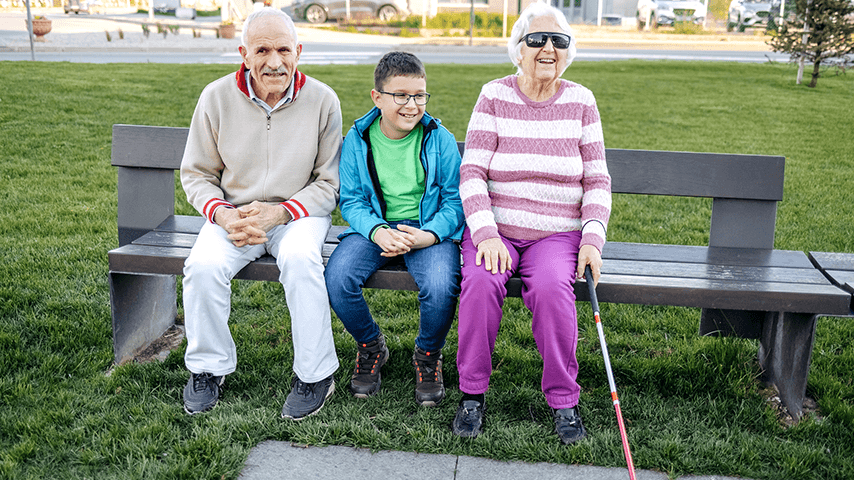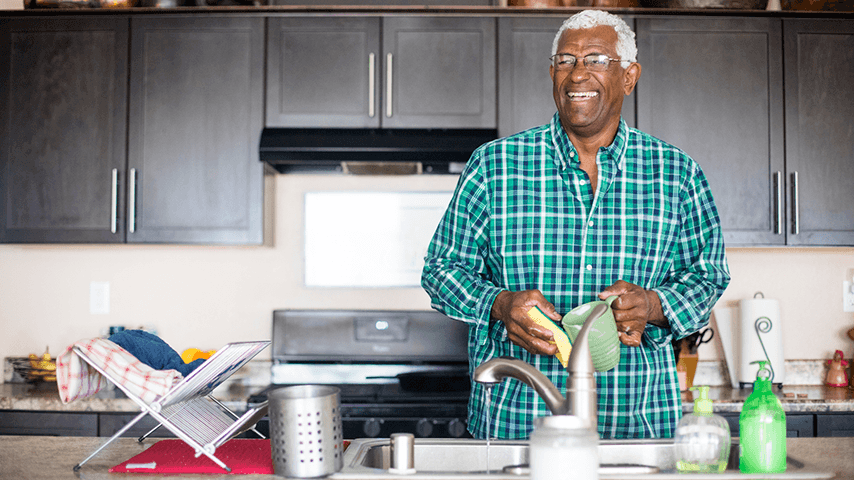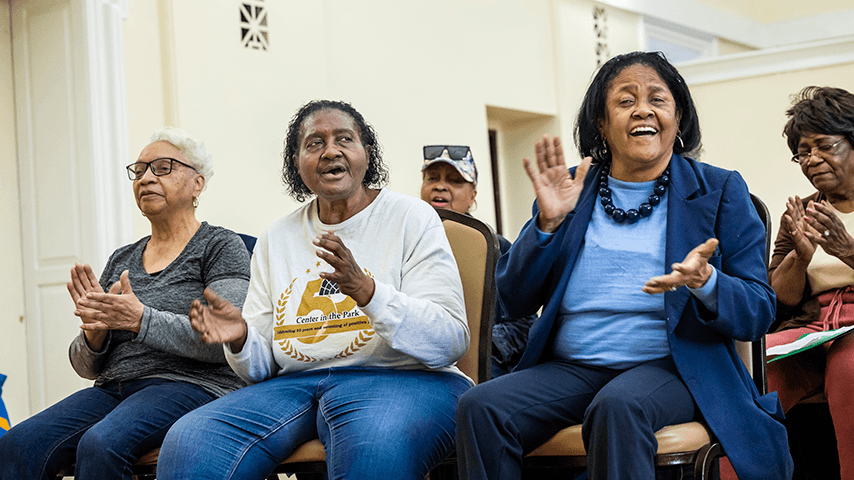Helping People with Blindness and Vision Loss Continue to Participate in Everyday Activities
6 min read

If your business, community center, senior center, medical or other type of facility caters to older Americans, making simple and affordable adjustments to accommodate those with low vision or blindness will create a safer and more comfortable environment for everyone.
It's crucial to create accessible environments for people with vision loss, especially considering the fact that more than 7% of people age 65+ in the US report blindness and low vision, and an estimated 12.5 million people in the US age 40+ experience vision impairment. By 2050, the number of people in the US with vision impairment is expected to increase by 118%.1
By creating a safe facility that is easy to navigate, you are welcoming older adults with vision impairment in a meaningful and life-enhancing way. You are also setting the stage for the next step of providing accommodations to ensure thoughtful interaction and delivery of services.
Using color to boost accessibility for people with blindless and vision loss
Creating color contrast in key areas and selecting furnishings that contrast floors and walls is a simple and cost-effective accessibility step.
Consider placing color-contrasting strips on steps and stairs to differentiate surface-level changes. You can also accentuate entry and exit points by employing a markedly light or darker door or dramatically contrasting the frame color of doors and exit areas. Using contrast also helps people with low vision understand how to best navigate between rooms in a multi-room facility. Light switches and outlets can also be painted a highly contrasting color, making it easier to differentiate them from walls.
Designing for visual imparement with textures
Tactile clues can likewise be helpful and simple to implement. For example, indicating indoor and outdoor walkways with varying textures can help with transitions from walkways to other building areas. This can be especially useful in large common rooms and reception areas, such as those in community centers.
Multiple types of textured flooring are available to create texture contrasts to modify existing floors.
Accommodating visually impaired people with lighting
Lighting is another important consideration. A benefit of having lighting to accommodate people with low vision is that it is often easier on everyone’s eyes. According to the American Federation for the Blind (AFB), “Individuals with low vision often benefit from maximizing lighting. However, there is no one ‘right’ source of light.” AFB also provides additional lighting tips.
With the vast array of lighting available today, all contributing factors should be considered before choosing the best fixtures for your space. Florescent lighting is bright, energy-efficient, and can be used with a dimmer switch to change intensity as needed, making it a good choice for larger rooms. For task lighting to best illuminate activities such as reading, playing cards, and crafting, WebMD recommends LED lighting, although long, intense exposure to LED is not recommended. Prevent Blindness offers invaluable information and recommendations for using various types of lighting.
But when it comes to light, more is not always better. Reducing glare from reflective surfaces will help create visual comfort for everyone. Explore the many options of adjustable window treatments that can reduce glare without eliminating natural light. Glare generated by artificial light can be controlled by dimmer switches or turning televisions and other electronic screens away from light sources.
Rethinking signage for low-vision accessibility
If your facility uses signage, designs with color contrast in lettering and graphic images make signs easier to read. Highly contrasting colors and bold fonts are vital.
The Americans with Disabilities Act (ADA) requires accessible signage in all businesses, including signage containing both visual and tactile characters, such as braille and raised characters. Multiple websites provide guidance for ADA compliance.
Putting safety first for people with visual impairment
Creating a safe environment is always a top priority, and special considerations to make a space safer for people with vision impairment benefits everyone.
Walk from the parking lot and around other outdoor areas of your facility to identify any uneven or varying surfaces, and consider adding markings and color contrast. Walk from the outside into your facility, then tour the entire facility giving special consideration to how each area might be perceived and navigated by a person with low vision. Enlist the assistance of someone with vision loss to tour the facility with you. Make notes of anything that could be adjusted to make the facility more welcoming, easier to navigate, and safer for all clients.
Eliminate trip hazards, paying close attention to loose carpets or rugs, obstructions in halls or walkways, chairs not tucked under desks or tables, file cabinet or desk drawers left extended, and any low overhangs, anything that extends out from a wall or hangs from the ceiling. Again, contrasting rugs and furniture and using contrast on variable surfaces such as curbs, steps, and stairs can reduce walking hazards for all. Contrasting railings can also assist people with low vision.
The importance of universal design: How it creates universal benefits for all
When planning a remodel or building a new facility, ask your designer or architect to include universal design concepts. According to the article Designing for the Blind, universal design is a ‘big tent’ term encompassing more familiar methods such as accessibility and ‘barrier-free’ design.2 If a design is truly universal—meaning it’s for everyone—it should be, by definition, accessible.
Everyone appreciates a warm welcome. Help your team better understand the unique needs of clients facing blindness or low vision with some of these tips:
- Greet clients or patients by introducing yourself and waiting for them to offer a handshake instead of taking their hand.
- Speak directly to individuals who are visually impaired, not the person accompanying them.
- Use precise directional phrases such as “turn left” or “walk about ten steps straight ahead” rather than vague directional language such as “over there.”
- Speak in the same tone and volume as you would with a sighted client or patient.
- Ask clients who are blind or visually impaired if they would like you to help guide them where they need to go. Offer your arm for assistance only If they say yes.
Easing paperwork headaches for the visually impaired
Timely and accurate completion of paperwork is often necessary in order for people to participate in activities or access your organization's services, and privacy is essential. The American Foundation for the Blind (AFB) suggests the following strategies to help streamline this crucial step:
- Consider providing forms ahead of time in an accessible format via email, regular mail, or, if requested, a braille copy provided on-site.
- Provide alternatives to print forms. Not everyone will be able to read regular type on paper. Some may prefer to receive an electronic copy of essential materials via email or text. Others may prefer you read aloud information or instructions or provide a braille copy.
- Consider on-site options for completing paperwork, such as having someone assist with this process.
- Ensure your organization’s website, portal, and any apps are accessible to those who are blind or have low vision and use a screen reader program. Many people with low vision find websites, portals, and apps difficult to navigate and would benefit from extra assistance.
Follow best practices, and create a welcoming space for everyone
AFB conducted a study to understand the barriers and challenges experienced by those with vision loss and to develop materials to support health care workers to meet the needs of this population. The result is their Best Practices Guide for Hospitals Interacting with People Who are Blind or Visually Impaired, an online resource guide featuring videos and hand-out materials for personnel at organizations that support people who are blind or visually impaired.
A broad range of simple modifications can dramatically enhance the experiences of clients facing blindness or low vision and those who serve them. Now is the perfect time to implement facility and client service accommodations to improve safety, enhance engagement, and strengthen relationships.
Sources
1. Rohit Varma, et al. Visual Impairment and Blindness in Adults in the United States, Demographic and Geographic Variations from 2015 to 2050. JAMA Ophthalmology. July 2016. Found on the internet at at https://jamanetwork.com/journals/jamaophthalmology/article-abstract/2523780
2. Jackie Craven. Designing for the Blind. ThoughtCo. Nov. 17, 2019. Found on the internet at https://www.thoughtco.com/designing-for-the-blind-3972260



